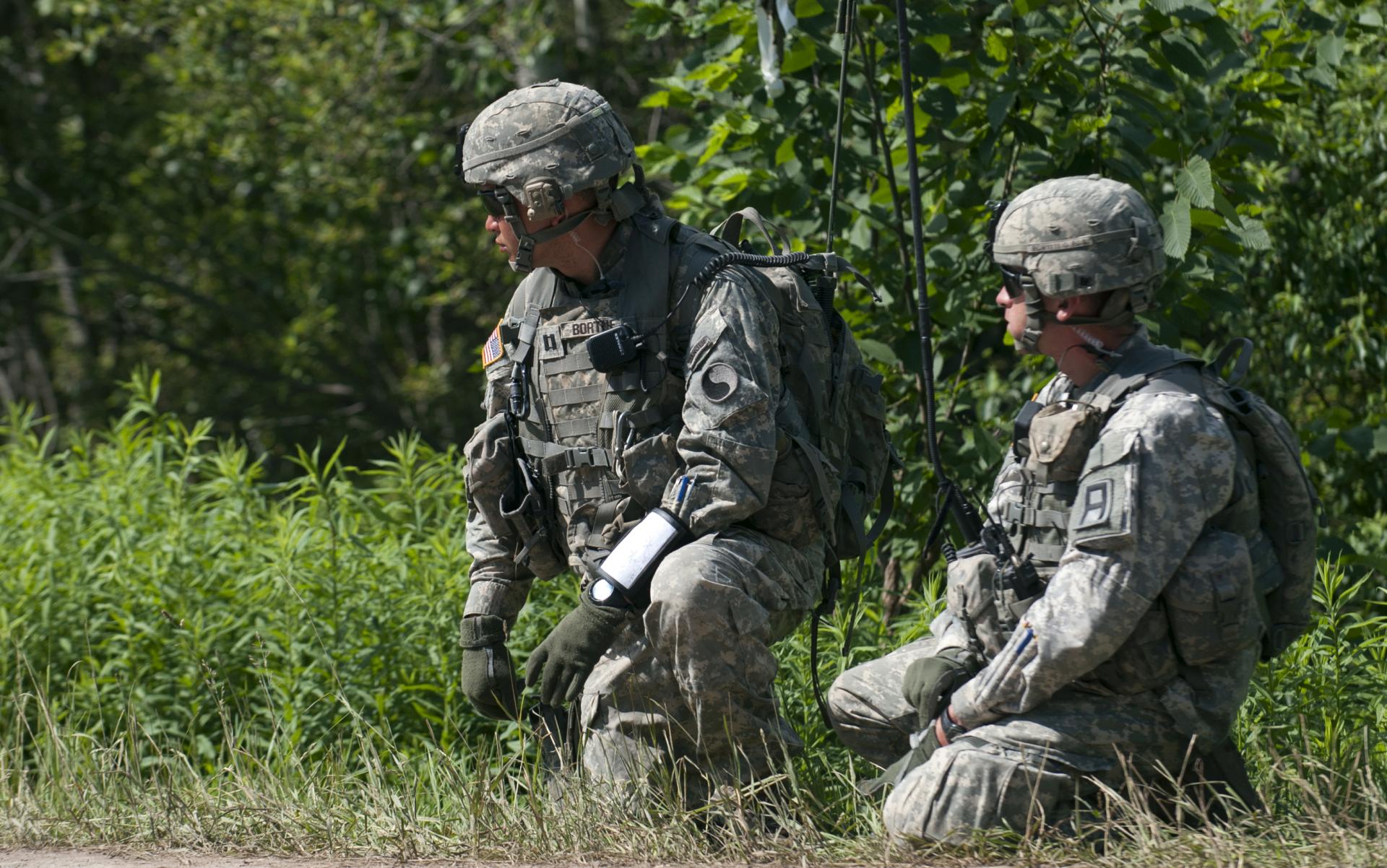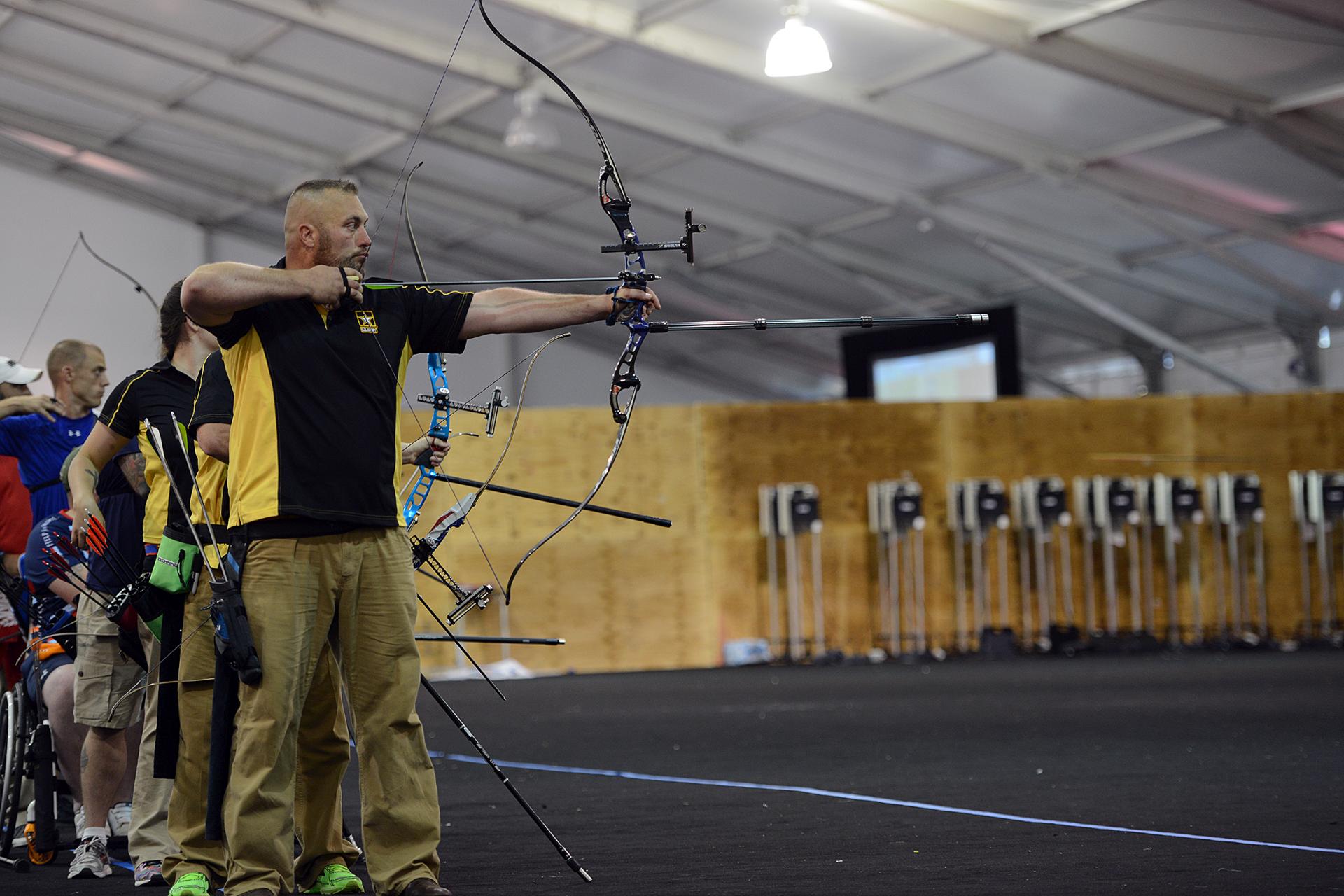Helping to ensure select Army National Guard units maintain readiness before deploying was the focus of the multi-echelon integrated brigade training, or MIBT, event held here, June 13-26.
This was the first MIBT, which addresses the training needs of National Guard brigade combat teams, also known as BCTs.
After a deployment, usually lasting about a year, a brigade combat team spends a year resetting, then a year conducting individual training. Year four features a culminating training event, and during year five, the unit is again available for deployment.
Ideally, BCTs have a combat training center, or CTC, rotation in training year three, but there aren’t enough slots to go around at the Joint Readiness Training Center on Fort Polk, Louisiana, and the National Training Center on Fort Irwin, California. This created a training gap for some brigade combat teams, and First Army created the MIBT to fill that gap.
Units trained during the first MIBT included the Virginia Army National Guard’s 116th Infantry Brigade Combat Team, the Vermont Army National Guard’s 86th Infantry Brigade Combat Team, and the New York Army National Guard’s 42nd Infantry Division Headquarters. Soldiers from the active-duty 10th Mountain Division’s 1st Brigade served as the opposing force. First Army designed the exercise and scenario development and also provided exercise control, warfighter support, and observer coach/trainers.
Maj. Gen. Jeffery Bailey, First Army Division East commander, said the MIBT offers many advantages.
“It provides a multi-echelon training environment, meaning that we can train individuals, crews, platoons, companies, battalions, brigades and divisions, all under the cover of one exercise,” he said. “During a typical annual training period, a National Guard brigade could do some multi-echelon training, but the problem is that they have to provide all the support requirement internally. When I was a battalion commander, I would have Alpha Company doing support, and Bravo and Charlie Company training, because there’s no free chicken when you’re training yourself.”
Besides the multi-echelon focus, the MIBT had a multi-component flavor, in support of Army Total Force Policy, or ATFP. This policy aims to ensure that active-duty Army, Army Reserve and Army National Guard assets are trained to the same standard. First Army is Forces Command’s designated coordinating authority for implementation of ATFP due to its unique training mission capabilities, experienced cadre, and expertise in Total Force readiness. Active-duty, Reserve, and National Guard assets were all incorporated into the exercise.
The MIBT uses different echelons and components to help ensure units will be ready to deploy when called upon.
“The design of the MBIT allows [units] who are either entering [training year three] or their available year to come together and train in a multi-echelon environment that they couldn’t do otherwise,” Bailey said. “You bring in the 42nd, who went through their warfighter last year, along with the 116th, who went through their brigade warfighter this year, with the 86th, who went to JRTC this year.
“It’s a sustainment-training capability that has never existed in the Army before. They can come in and train in … a CTC-like environment. Once they go to the field, they are moving into a tactical environment and operating 24-7. The MBIT is an opportunity to keep their skills sharp and extend the value of the readiness we have developed.”
While First Army filled its usual OC/T role, it also developed and planned the exercise.
“It is a quantum leap in complexity beyond what we do in any other training exercise,” Bailey said. “This is a division, two brigades, Army Reserve units, and active-duty components supporting this. It’s huge; it’s a much more complex set of events that have to be developed. This has never happened before. This is the first time the Army has done something like this that I am aware of.
“National Guard, active-duty and Army Reserve assets are all training together in a multi-echelon, functional environment.”
The exercise objectives included sustaining mission essential task list-proficiency for National Guard BCTs and division headquarters, and providing integrated training for Army National Guard and active-component combined arms battalions. The MIBT was conducted alongside a combat support training exercise using the same scenario, which helped sharpen the units’ abilities to succeed in multi-component and multifunctional areas.
In remarks to Soldiers of the 116th IBCT, 42nd Infantry Division Commander Maj. Gen. Harry Miller Jr., stressed the value of the MIBT.
“This exercise is designed to sustain your readiness; that’s what this is all about,” he said. “This is a time and place to learn and to make mistakes. Learn from what the OC/Ts are telling you.”
“We have a good plan. It’s not perfect, but that’s why we’re here,” Col. Andrew Harris, deputy commander of the 116th IBCT, told his Soldiers. “We’ve gotten some great assistance from our teammates at First Army and I’m very grateful for their support. We’ve worked well together so far and we will continue to do so. This gives us the chance to continue our momentum and keep our readiness at a high level.”
Soldiers, from the 42nd Infantry Division, acted as higher command for the brigades being trained. Chief Warrant Officer 4 Kevin Hart, a construction engineer technician with the 42nd, said that National Guard units sometimes don’t get a CTC rotation during training year three, resulting in some Guard Soldiers going for years without experiencing one.
“The problem with the Reserve and National Guard is personnel consistency. You have new people all the time, so it’s good to have training like this,” Hart said.
Participating in the MIBT will pay off down the road, he said. “It’s an excellent training opportunity that First Army has put together,” Hart said. “There are a lot of advantages to doing multi-echelon and multi-component training, because those [situations] will be replicated in theatre. It’s a chance to smooth out the communications, logistics and other aspects between one command and another.”
Lt. Col. Bruce Alzner of First Army Training served as lead planner for the MIBT. He described First Army’s role in the exercise as being “responsible for coordinating, planning, supporting and overseeing the execution of the exercise.”
Alzner said the MIBT’s biggest challenge was a truncated timeline, with just seven months to develop the exercise. Normally, planners have 18 months to develop an event of this scale. There was also the challenge of the MIBT’s unprecedented nature.
“The first time you do something like this, it’s called the ‘proof of concept.’ Someone had this idea, all this planning goes into it, and you’re proofing it to see if it’s going to work,” he said. “I think we can say we’re successful if we can plan an exercise that increases readiness in the brigade and allows the brigade commander to reach his training goals. Units will get something that is bigger and better than what they could do on their own at their home station for annual training. We want to help those brigade combat team commanders meet their training objectives that they would meet had they gone to a CTC.”
Those training objectives are being met, said Col. Samuel Fryer, exercise branch chief for the 75th Training Command, a Reserve unit, which supported the MIBT by providing mission command enablers for brigade and battalion staff. Fryer said the MIBT is giving units a CTC-like experience.
“I’ve worked in the combat training center arena for several years as a civilian. What I see here is replicating that,” he said. “National Guard units don’t necessarily have the same opportunity to go to a combat training center, so this gives them something similar.”











